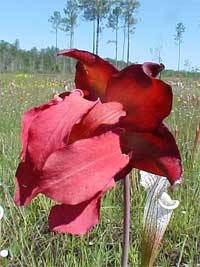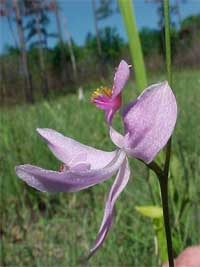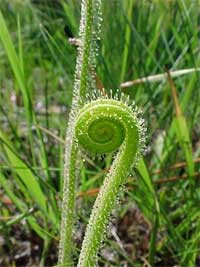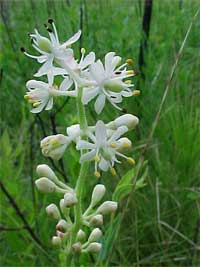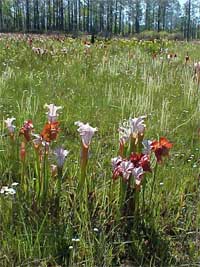USDA Forest Service Celebrating Wildflowers
|
|
|
Southern Region Viewing AreaLOCATION and PHOTOS
Parker Springs BogForest: National Forests in Alabama District: Conecuh Ranger District Description: Parker Springs Bog is an excellent example of how an East Gulf Coastal Plain bog should look. Located on the western side of the Conecuh Unit, this hillside bog has been specifically managed for bog characteristics. It is easy for plant enthusiasts to get sidetracked even before reaching the bog. Often botanical folks do not even get past the first ditches on the way to access Parker Springs Bog. Several unique species are visible immediately, but it only gets better. There is no doubt when the transition to the bog proper is reached. Even amateur visitors are highly impressed by the incredible carnivorous plant species and sheer diversity of plants to be found in this area. Fire & water have long played important roles in shaping and maintaining the ecological health of these bog complexes, which are embedded in the longleaf pine ecosystem. Frequent prescribed burning helps regenerate and provide nutrients to the bog community. Removal of overstory trees and encroaching shrubs not only in the bog, but in the upland, allow the uplands to act as recharge areas, providing the water upon which the bog depends. Ongoing restoration and ecosystem management, often tailored specifically to the rare communities, have allowed the Conecuh National Forest to function as a biological refugia for unique, embedded communities and endemic plant species. Viewing Information: The most impressive time to view Parker Springs Bog is in May. Although flowering of some species actually begins in February and continue through October, May seems to be the time of year when the most plant species are blooming at the same time. One might catch the late blooming of Grass-pink orchids (Calopogon spp) or the early blooming of Coastal Plain Aster (Pityopsis oligiantha). By far the most eye-catching, however, are the carnivorous plants in bloom. Several species of Pitcher plants (Sarracenia spp), Sundews (Drosera spp), Bladderworts (Utricularia spp) and Butterworts (Pinguicula spp) can be found in Parker Springs Bog. Visitors will be enchanted with the closer views of the plants and area, and often can be heard calling out new discoveries as yet another bloom or plant is found. Parker Springs Bog is part of a rather large complex of bogs that lies around each of the feeder streams running into Brook Hines Lake. Enthusiasts may find themselves venturing quite far afield, following each new discovery and venturing further along the bog complex. The biggest challenge may not be finding the area, but knowing when to quit. Botanists have been known to spend hours unaware of the time, only to realize they are trying to identify plants by the vehicle headlights. Safety First: Be prepared for hot muggy weather (temperatures in the mid to upper 90s and humidity ranging from 80-100%); wear suitable clothing for the conditions, including long pants, hats and sun protection. Since some areas will be wet & muddy, waterproof boots are recommended. Drinking water is a must. Insect repellent is preferable, as there is a chance of ticks, chiggers & mosquitoes in the area. There is also a chance of the occurrence of not only non-poisonous, but a slight chance of encountering poisonous snakes such as water moccasins, canebrake rattlesnakes or coral snakes. High-topped boots are recommended. Park any vehicles well off the road. Directions: Take Hwy 29 West out of Andalusia, Alabama. Turn South on State Hwy 137, continue to Wing, Alabama. Turn west on to county road 4, continue on until it joins with CR 11. Turn South on County Road 11 when it branches off. After about 2 ½ miles, the road with branch, with a sign Parker Springs Road/Brook Hines Lake; take the west fork (gravel/dirt road). In less than a mile, the road will fork again, bear west again. Just past where the road forks, on the south side of the road, is where Parker Springs Bog begins. On the north side of the road is private land. Ownership and Management: U.S. Forest Service. The bog complex also occurs on the North and West side of the road, but it is on private property. Conecuh Ranger District, (334) 222-2555. Closest Town: Andalusia, Alabama. |
|
| NOTE: PDF format links require the Adobe Acrobat Reader to view. | |
| top | Disclaimers | FOIA | Privacy Policy | Quality of Information | Photo Credits & Use |
Location: http://www.fs.fed.us/wildflowers/regions/southern/ParkerSpringsBog/index.shtml
Last modified: Tuesday, 24-Jun-2008 21:57:31 EDT
